Nursing EBP: Mentorship Program Impact on Clinical Practice & Outcomes
VerifiedAdded on 2023/06/11
|6
|1427
|210
Essay
AI Summary
This essay provides an overview of evidence-based practice (EBP) in nursing, emphasizing its role in improving clinical decision-making and patient outcomes. It summarizes a research article by Wallen et al. (2010) on the effectiveness of a structured multifaceted mentorship program for EBP implementation, highlighting the importance of leadership and staff engagement in fostering an EBP culture. The essay outlines the seven steps of EBP, from cultivating a spirit of inquiry to disseminating results, and applies these principles to the practice problem of infection control in clinical settings. It underscores the role of nurses in preventing healthcare-associated infections through evidence-based guidelines and policies, ultimately aiming to enhance patient satisfaction and professional practice. The essay concludes that continuous research and EBP engagement are crucial for augmenting nursing practice and improving patient care.

Running head: NURSING
Nursing
Name of student:
Name of university:
Author note:
Nursing
Name of student:
Name of university:
Author note:
Paraphrase This Document
Need a fresh take? Get an instant paraphrase of this document with our AI Paraphraser
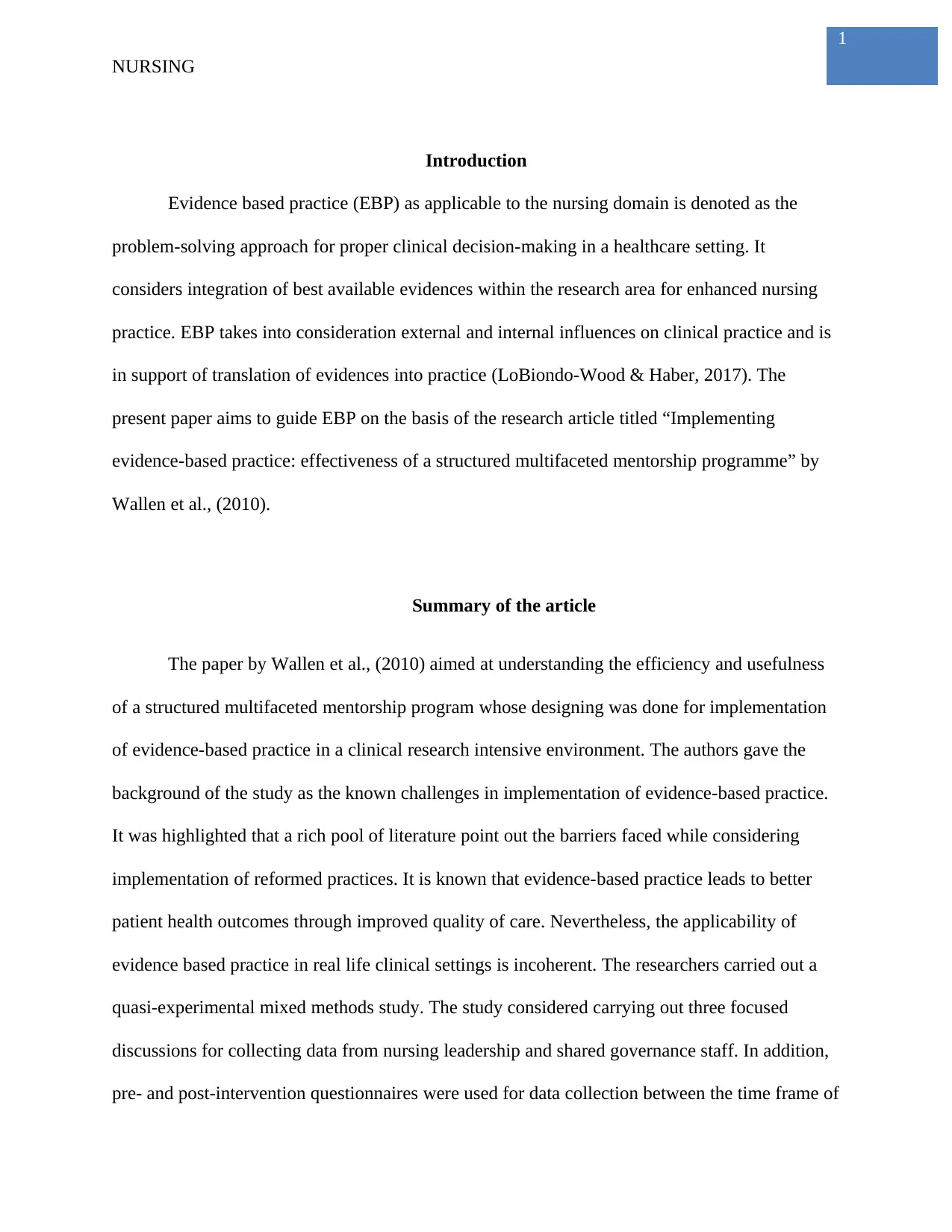
1
NURSING
Introduction
Evidence based practice (EBP) as applicable to the nursing domain is denoted as the
problem-solving approach for proper clinical decision-making in a healthcare setting. It
considers integration of best available evidences within the research area for enhanced nursing
practice. EBP takes into consideration external and internal influences on clinical practice and is
in support of translation of evidences into practice (LoBiondo-Wood & Haber, 2017). The
present paper aims to guide EBP on the basis of the research article titled “Implementing
evidence-based practice: effectiveness of a structured multifaceted mentorship programme” by
Wallen et al., (2010).
Summary of the article
The paper by Wallen et al., (2010) aimed at understanding the efficiency and usefulness
of a structured multifaceted mentorship program whose designing was done for implementation
of evidence-based practice in a clinical research intensive environment. The authors gave the
background of the study as the known challenges in implementation of evidence-based practice.
It was highlighted that a rich pool of literature point out the barriers faced while considering
implementation of reformed practices. It is known that evidence-based practice leads to better
patient health outcomes through improved quality of care. Nevertheless, the applicability of
evidence based practice in real life clinical settings is incoherent. The researchers carried out a
quasi-experimental mixed methods study. The study considered carrying out three focused
discussions for collecting data from nursing leadership and shared governance staff. In addition,
pre- and post-intervention questionnaires were used for data collection between the time frame of
NURSING
Introduction
Evidence based practice (EBP) as applicable to the nursing domain is denoted as the
problem-solving approach for proper clinical decision-making in a healthcare setting. It
considers integration of best available evidences within the research area for enhanced nursing
practice. EBP takes into consideration external and internal influences on clinical practice and is
in support of translation of evidences into practice (LoBiondo-Wood & Haber, 2017). The
present paper aims to guide EBP on the basis of the research article titled “Implementing
evidence-based practice: effectiveness of a structured multifaceted mentorship programme” by
Wallen et al., (2010).
Summary of the article
The paper by Wallen et al., (2010) aimed at understanding the efficiency and usefulness
of a structured multifaceted mentorship program whose designing was done for implementation
of evidence-based practice in a clinical research intensive environment. The authors gave the
background of the study as the known challenges in implementation of evidence-based practice.
It was highlighted that a rich pool of literature point out the barriers faced while considering
implementation of reformed practices. It is known that evidence-based practice leads to better
patient health outcomes through improved quality of care. Nevertheless, the applicability of
evidence based practice in real life clinical settings is incoherent. The researchers carried out a
quasi-experimental mixed methods study. The study considered carrying out three focused
discussions for collecting data from nursing leadership and shared governance staff. In addition,
pre- and post-intervention questionnaires were used for data collection between the time frame of
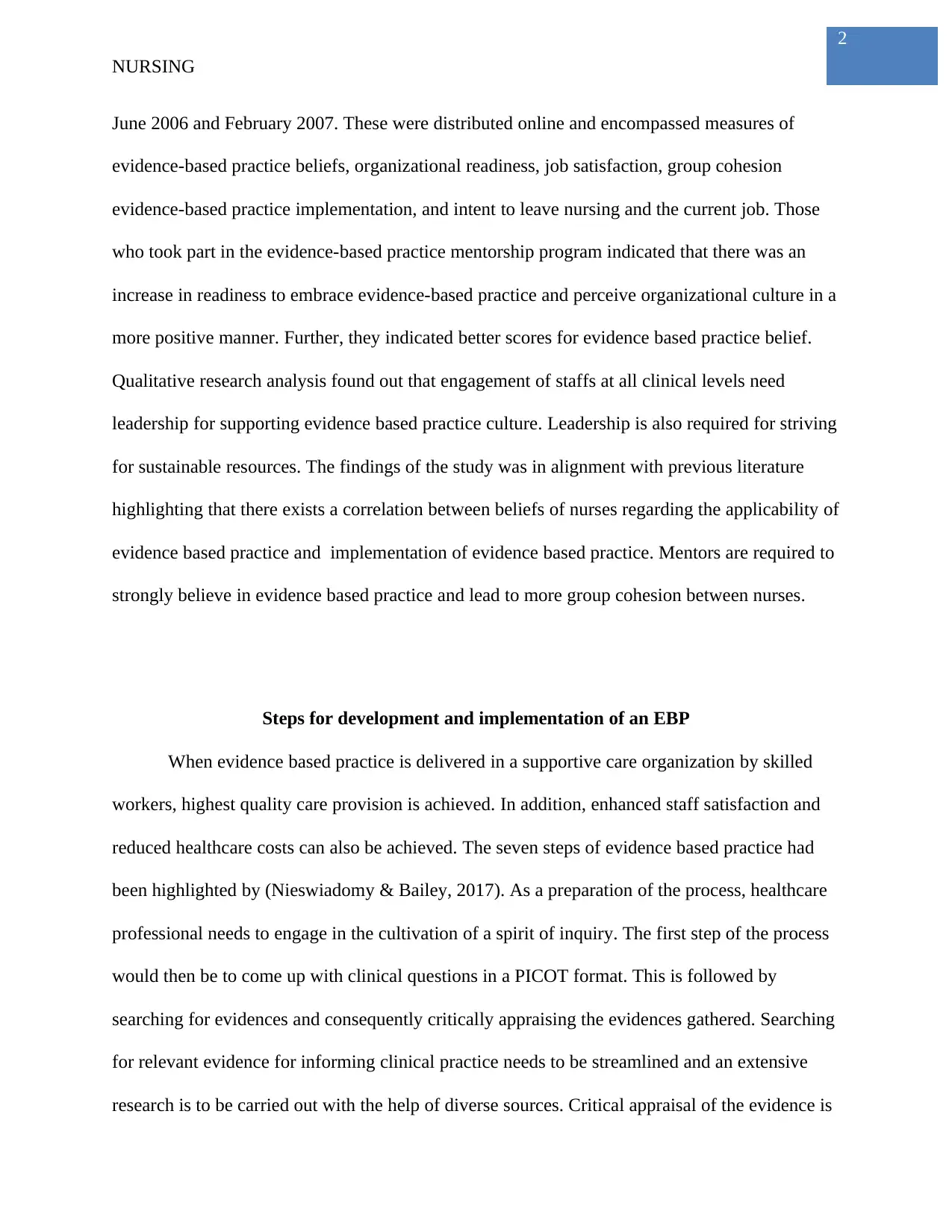
2
NURSING
June 2006 and February 2007. These were distributed online and encompassed measures of
evidence-based practice beliefs, organizational readiness, job satisfaction, group cohesion
evidence-based practice implementation, and intent to leave nursing and the current job. Those
who took part in the evidence-based practice mentorship program indicated that there was an
increase in readiness to embrace evidence-based practice and perceive organizational culture in a
more positive manner. Further, they indicated better scores for evidence based practice belief.
Qualitative research analysis found out that engagement of staffs at all clinical levels need
leadership for supporting evidence based practice culture. Leadership is also required for striving
for sustainable resources. The findings of the study was in alignment with previous literature
highlighting that there exists a correlation between beliefs of nurses regarding the applicability of
evidence based practice and implementation of evidence based practice. Mentors are required to
strongly believe in evidence based practice and lead to more group cohesion between nurses.
Steps for development and implementation of an EBP
When evidence based practice is delivered in a supportive care organization by skilled
workers, highest quality care provision is achieved. In addition, enhanced staff satisfaction and
reduced healthcare costs can also be achieved. The seven steps of evidence based practice had
been highlighted by (Nieswiadomy & Bailey, 2017). As a preparation of the process, healthcare
professional needs to engage in the cultivation of a spirit of inquiry. The first step of the process
would then be to come up with clinical questions in a PICOT format. This is followed by
searching for evidences and consequently critically appraising the evidences gathered. Searching
for relevant evidence for informing clinical practice needs to be streamlined and an extensive
research is to be carried out with the help of diverse sources. Critical appraisal of the evidence is
NURSING
June 2006 and February 2007. These were distributed online and encompassed measures of
evidence-based practice beliefs, organizational readiness, job satisfaction, group cohesion
evidence-based practice implementation, and intent to leave nursing and the current job. Those
who took part in the evidence-based practice mentorship program indicated that there was an
increase in readiness to embrace evidence-based practice and perceive organizational culture in a
more positive manner. Further, they indicated better scores for evidence based practice belief.
Qualitative research analysis found out that engagement of staffs at all clinical levels need
leadership for supporting evidence based practice culture. Leadership is also required for striving
for sustainable resources. The findings of the study was in alignment with previous literature
highlighting that there exists a correlation between beliefs of nurses regarding the applicability of
evidence based practice and implementation of evidence based practice. Mentors are required to
strongly believe in evidence based practice and lead to more group cohesion between nurses.
Steps for development and implementation of an EBP
When evidence based practice is delivered in a supportive care organization by skilled
workers, highest quality care provision is achieved. In addition, enhanced staff satisfaction and
reduced healthcare costs can also be achieved. The seven steps of evidence based practice had
been highlighted by (Nieswiadomy & Bailey, 2017). As a preparation of the process, healthcare
professional needs to engage in the cultivation of a spirit of inquiry. The first step of the process
would then be to come up with clinical questions in a PICOT format. This is followed by
searching for evidences and consequently critically appraising the evidences gathered. Searching
for relevant evidence for informing clinical practice needs to be streamlined and an extensive
research is to be carried out with the help of diverse sources. Critical appraisal of the evidence is
⊘ This is a preview!⊘
Do you want full access?
Subscribe today to unlock all pages.

Trusted by 1+ million students worldwide
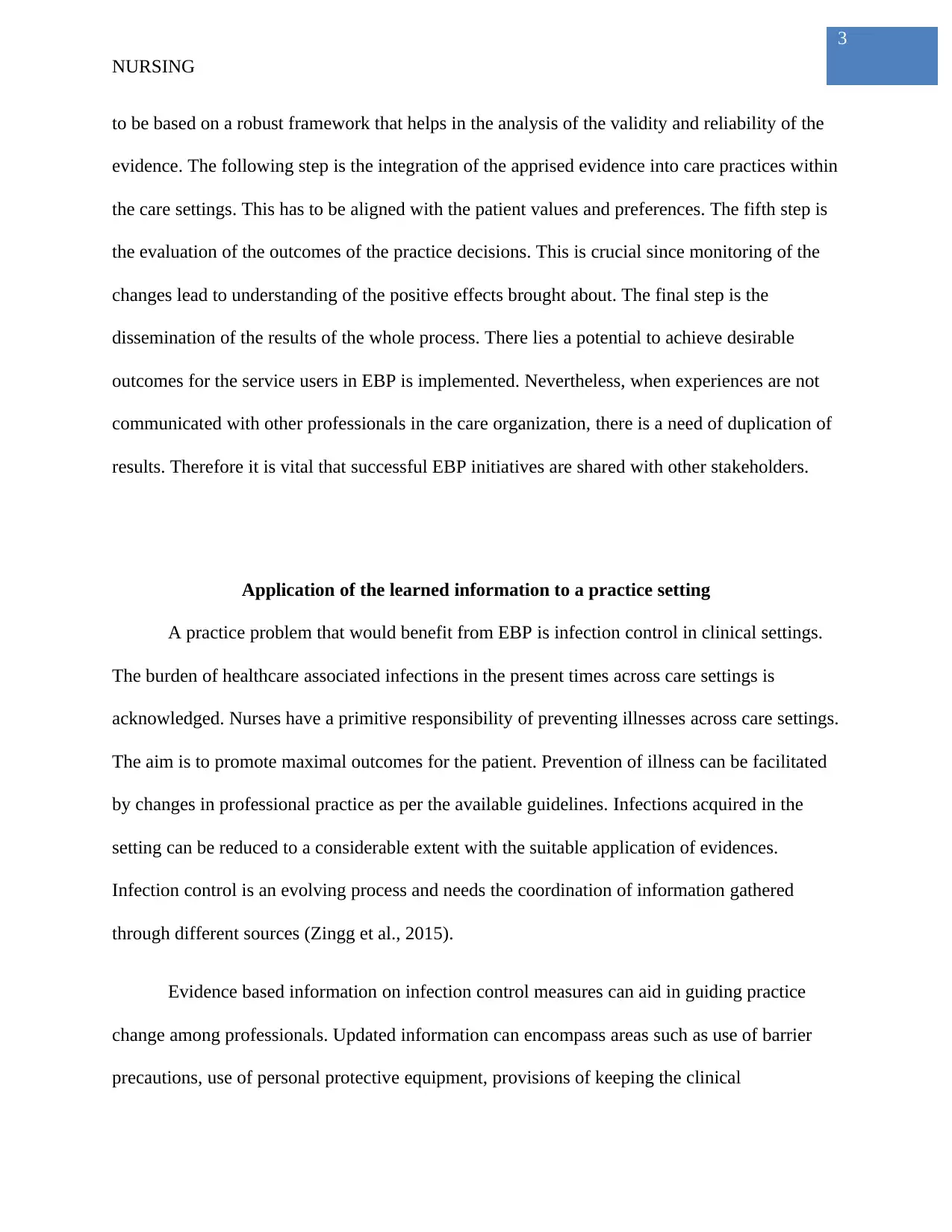
3
NURSING
to be based on a robust framework that helps in the analysis of the validity and reliability of the
evidence. The following step is the integration of the apprised evidence into care practices within
the care settings. This has to be aligned with the patient values and preferences. The fifth step is
the evaluation of the outcomes of the practice decisions. This is crucial since monitoring of the
changes lead to understanding of the positive effects brought about. The final step is the
dissemination of the results of the whole process. There lies a potential to achieve desirable
outcomes for the service users in EBP is implemented. Nevertheless, when experiences are not
communicated with other professionals in the care organization, there is a need of duplication of
results. Therefore it is vital that successful EBP initiatives are shared with other stakeholders.
Application of the learned information to a practice setting
A practice problem that would benefit from EBP is infection control in clinical settings.
The burden of healthcare associated infections in the present times across care settings is
acknowledged. Nurses have a primitive responsibility of preventing illnesses across care settings.
The aim is to promote maximal outcomes for the patient. Prevention of illness can be facilitated
by changes in professional practice as per the available guidelines. Infections acquired in the
setting can be reduced to a considerable extent with the suitable application of evidences.
Infection control is an evolving process and needs the coordination of information gathered
through different sources (Zingg et al., 2015).
Evidence based information on infection control measures can aid in guiding practice
change among professionals. Updated information can encompass areas such as use of barrier
precautions, use of personal protective equipment, provisions of keeping the clinical
NURSING
to be based on a robust framework that helps in the analysis of the validity and reliability of the
evidence. The following step is the integration of the apprised evidence into care practices within
the care settings. This has to be aligned with the patient values and preferences. The fifth step is
the evaluation of the outcomes of the practice decisions. This is crucial since monitoring of the
changes lead to understanding of the positive effects brought about. The final step is the
dissemination of the results of the whole process. There lies a potential to achieve desirable
outcomes for the service users in EBP is implemented. Nevertheless, when experiences are not
communicated with other professionals in the care organization, there is a need of duplication of
results. Therefore it is vital that successful EBP initiatives are shared with other stakeholders.
Application of the learned information to a practice setting
A practice problem that would benefit from EBP is infection control in clinical settings.
The burden of healthcare associated infections in the present times across care settings is
acknowledged. Nurses have a primitive responsibility of preventing illnesses across care settings.
The aim is to promote maximal outcomes for the patient. Prevention of illness can be facilitated
by changes in professional practice as per the available guidelines. Infections acquired in the
setting can be reduced to a considerable extent with the suitable application of evidences.
Infection control is an evolving process and needs the coordination of information gathered
through different sources (Zingg et al., 2015).
Evidence based information on infection control measures can aid in guiding practice
change among professionals. Updated information can encompass areas such as use of barrier
precautions, use of personal protective equipment, provisions of keeping the clinical
Paraphrase This Document
Need a fresh take? Get an instant paraphrase of this document with our AI Paraphraser
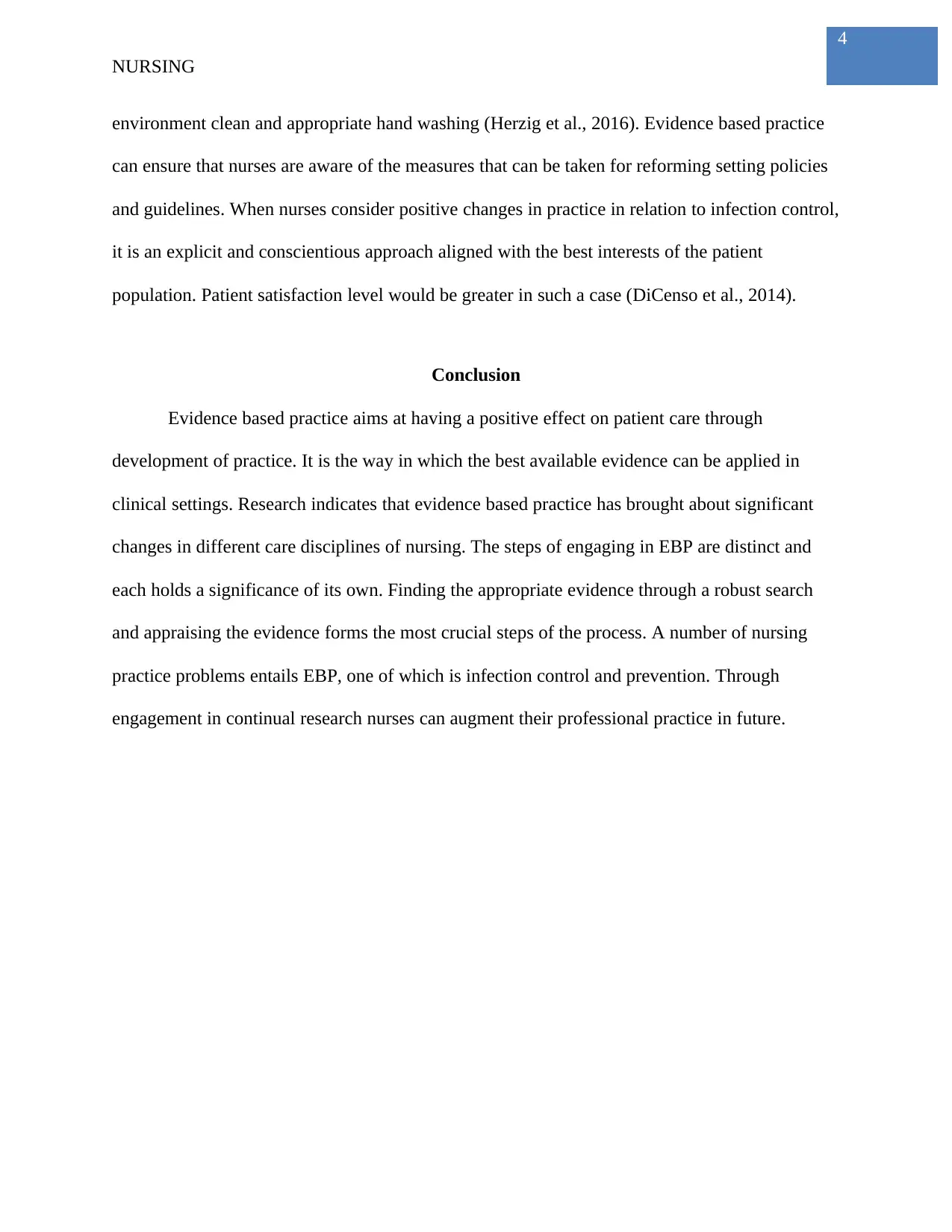
4
NURSING
environment clean and appropriate hand washing (Herzig et al., 2016). Evidence based practice
can ensure that nurses are aware of the measures that can be taken for reforming setting policies
and guidelines. When nurses consider positive changes in practice in relation to infection control,
it is an explicit and conscientious approach aligned with the best interests of the patient
population. Patient satisfaction level would be greater in such a case (DiCenso et al., 2014).
Conclusion
Evidence based practice aims at having a positive effect on patient care through
development of practice. It is the way in which the best available evidence can be applied in
clinical settings. Research indicates that evidence based practice has brought about significant
changes in different care disciplines of nursing. The steps of engaging in EBP are distinct and
each holds a significance of its own. Finding the appropriate evidence through a robust search
and appraising the evidence forms the most crucial steps of the process. A number of nursing
practice problems entails EBP, one of which is infection control and prevention. Through
engagement in continual research nurses can augment their professional practice in future.
NURSING
environment clean and appropriate hand washing (Herzig et al., 2016). Evidence based practice
can ensure that nurses are aware of the measures that can be taken for reforming setting policies
and guidelines. When nurses consider positive changes in practice in relation to infection control,
it is an explicit and conscientious approach aligned with the best interests of the patient
population. Patient satisfaction level would be greater in such a case (DiCenso et al., 2014).
Conclusion
Evidence based practice aims at having a positive effect on patient care through
development of practice. It is the way in which the best available evidence can be applied in
clinical settings. Research indicates that evidence based practice has brought about significant
changes in different care disciplines of nursing. The steps of engaging in EBP are distinct and
each holds a significance of its own. Finding the appropriate evidence through a robust search
and appraising the evidence forms the most crucial steps of the process. A number of nursing
practice problems entails EBP, one of which is infection control and prevention. Through
engagement in continual research nurses can augment their professional practice in future.
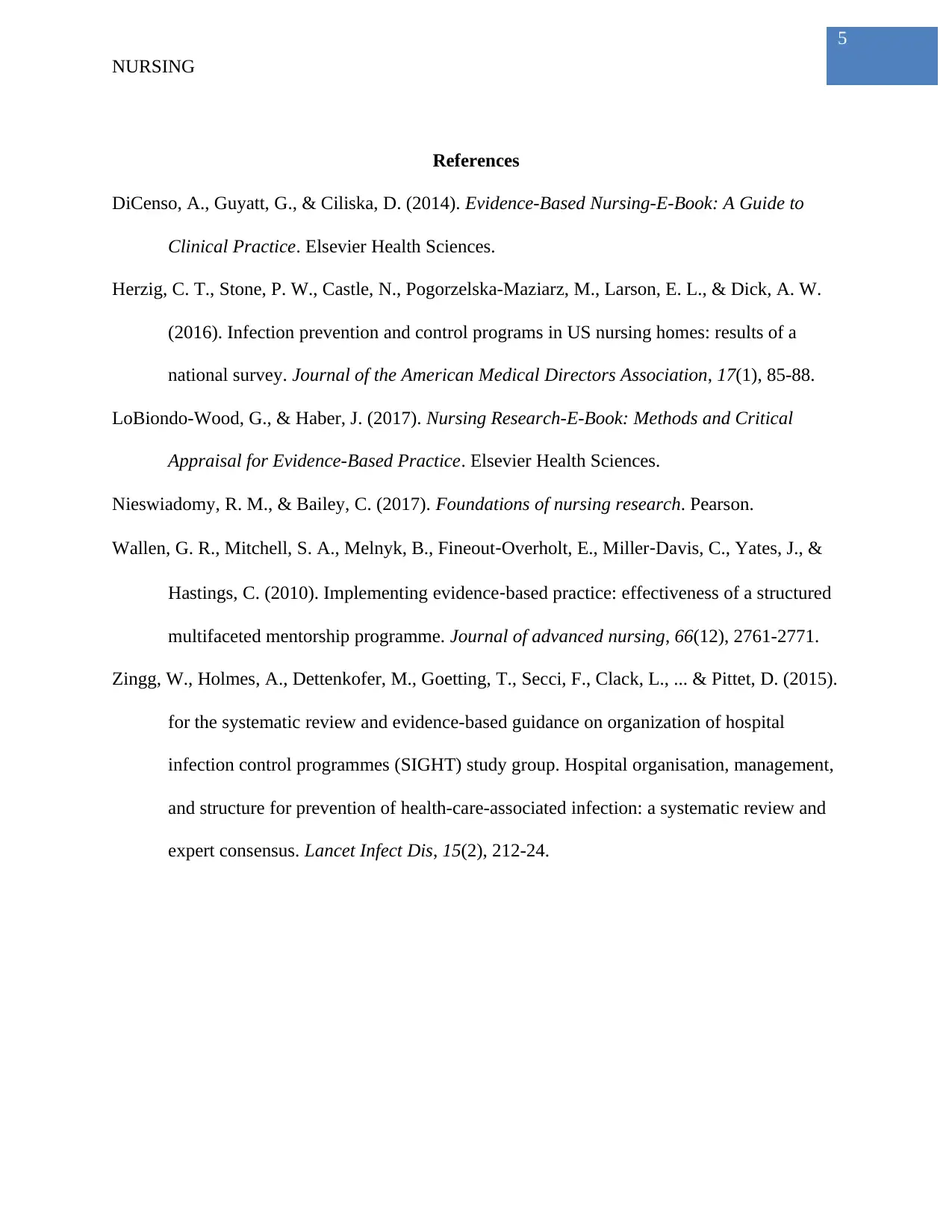
5
NURSING
References
DiCenso, A., Guyatt, G., & Ciliska, D. (2014). Evidence-Based Nursing-E-Book: A Guide to
Clinical Practice. Elsevier Health Sciences.
Herzig, C. T., Stone, P. W., Castle, N., Pogorzelska-Maziarz, M., Larson, E. L., & Dick, A. W.
(2016). Infection prevention and control programs in US nursing homes: results of a
national survey. Journal of the American Medical Directors Association, 17(1), 85-88.
LoBiondo-Wood, G., & Haber, J. (2017). Nursing Research-E-Book: Methods and Critical
Appraisal for Evidence-Based Practice. Elsevier Health Sciences.
Nieswiadomy, R. M., & Bailey, C. (2017). Foundations of nursing research. Pearson.
Wallen, G. R., Mitchell, S. A., Melnyk, B., Fineout‐Overholt, E., Miller‐Davis, C., Yates, J., &
Hastings, C. (2010). Implementing evidence‐based practice: effectiveness of a structured
multifaceted mentorship programme. Journal of advanced nursing, 66(12), 2761-2771.
Zingg, W., Holmes, A., Dettenkofer, M., Goetting, T., Secci, F., Clack, L., ... & Pittet, D. (2015).
for the systematic review and evidence-based guidance on organization of hospital
infection control programmes (SIGHT) study group. Hospital organisation, management,
and structure for prevention of health-care-associated infection: a systematic review and
expert consensus. Lancet Infect Dis, 15(2), 212-24.
NURSING
References
DiCenso, A., Guyatt, G., & Ciliska, D. (2014). Evidence-Based Nursing-E-Book: A Guide to
Clinical Practice. Elsevier Health Sciences.
Herzig, C. T., Stone, P. W., Castle, N., Pogorzelska-Maziarz, M., Larson, E. L., & Dick, A. W.
(2016). Infection prevention and control programs in US nursing homes: results of a
national survey. Journal of the American Medical Directors Association, 17(1), 85-88.
LoBiondo-Wood, G., & Haber, J. (2017). Nursing Research-E-Book: Methods and Critical
Appraisal for Evidence-Based Practice. Elsevier Health Sciences.
Nieswiadomy, R. M., & Bailey, C. (2017). Foundations of nursing research. Pearson.
Wallen, G. R., Mitchell, S. A., Melnyk, B., Fineout‐Overholt, E., Miller‐Davis, C., Yates, J., &
Hastings, C. (2010). Implementing evidence‐based practice: effectiveness of a structured
multifaceted mentorship programme. Journal of advanced nursing, 66(12), 2761-2771.
Zingg, W., Holmes, A., Dettenkofer, M., Goetting, T., Secci, F., Clack, L., ... & Pittet, D. (2015).
for the systematic review and evidence-based guidance on organization of hospital
infection control programmes (SIGHT) study group. Hospital organisation, management,
and structure for prevention of health-care-associated infection: a systematic review and
expert consensus. Lancet Infect Dis, 15(2), 212-24.
⊘ This is a preview!⊘
Do you want full access?
Subscribe today to unlock all pages.

Trusted by 1+ million students worldwide
1 out of 6
Related Documents
Your All-in-One AI-Powered Toolkit for Academic Success.
+13062052269
info@desklib.com
Available 24*7 on WhatsApp / Email
![[object Object]](/_next/static/media/star-bottom.7253800d.svg)
Unlock your academic potential
Copyright © 2020–2025 A2Z Services. All Rights Reserved. Developed and managed by ZUCOL.





